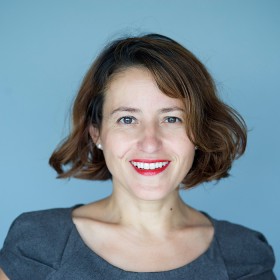The Many Faces of Isaac and Ismael, Part 4
Our special exhibition, “Obedience. An Installation in 15 Rooms by Saskia Boddeke & Peter Greenaway,” has been extended until 15 November 2015. The multimedia art installation takes on the sons’ perspectives of this biblical story, when Abraham intended to sacrifice his son in fulfillment of God’s command. In a film projection at the beginning of the exhibition, visitors are greeted by children, youth and young adults with the words, “I am Isaac” or “I am Ismael,” in a variety of languages.
There’s an interactive component to the exhibition, located in the Eric F. Ross Gallery on the ground floor of the Libeskind Building: A video box where visitors can express these words in their own way and, in so doing, more strongly identify with the child perspective of this story of the attempted sacrifice. We’ve presented a small selection of these video clips on the blog over the last several months.
Lisa Albrecht, continuing her task of compiling the clips, has concluded that Isaac and Ismael not only have many faces, but also many names.
However, not all Museum guests are so ‘obedient’ in fulfilling the video box’s intended purpose: → continue reading
Impressions of the “Obedience” Exhibition, from Muslim and Christian Perspectives
During the recent “Long Night of Museums” event, visitors were given a unique introduction to our current temporary exhibition “Obedience. An Installation in 15 Rooms by Saskia Boddeke & Peter Greenaway,” when the imam Emine Erol and the pastor Silke Radosh-Hinder led guided tours together. We asked the two women what they made of the occasion, and whether the joint guided tours had opened up novel views and perspectives on the biblical story.
Ms Erol, Ms Radosh-Hinder, would each of you describe the exhibition in your own words?
Silke Radosh-Hinder: For me, the exhibition is above all an opportunity to examine the story of the Binding of Isaac from a myriad of perspectives.
Emine Erol: The primary focus of the Obedience exhibition is the frame of mind of Ismael/Isaak respectively of his father Abraham. By prompting an emotional response and reflection, it helps visitors understand, ultimately, that such surrender may be dangerous or possibly even fatal—and also to understand what may motivate it. → continue reading
The “Daughters and Sons of Gastarbeiters” (guest workers) are the Academy of the Jewish Museum Berlin’s guest on 14 October 2015, part of the “New German Stories” series. As children, these Berlin authors followed their parents to Germany from their home villages in Anatolia, southern Europe and the Balkans, or they were born into working-class neighborhoods around Germany. Their mothers and fathers were supposed to bolster the German economic recovery as mere “guest workers”. The authors tell their personal stories, look back, follow their parents’ paths and thus add to Germany’s culture of memory. In advance of the event, we’ve asked three questions of Çiçek Bacık, the project’s leader and co-initiator:

Çiçek Bacık © Neda Navaee
Ms. Bacık, how did the “Daughters and Sons of Gastarbeiters” come to be and what was the motivation to tell these personal stories?
Last year, I went to a reading with my friend, the journalist Ferda Ataman. We were sitting in a bar afterwards. “Ferda, we have to start telling our stories and share them with others. We ourselves have to shed light on a dark chapter of our past we’ve successfully repressed,” I said. “Sure, and what’s stopping us?” That was the starting point for “Daughters and Sons of Gastarbeiters”. Our first reading took place in January 2015 at the Wasserturm in Kreuzberg. → continue reading
